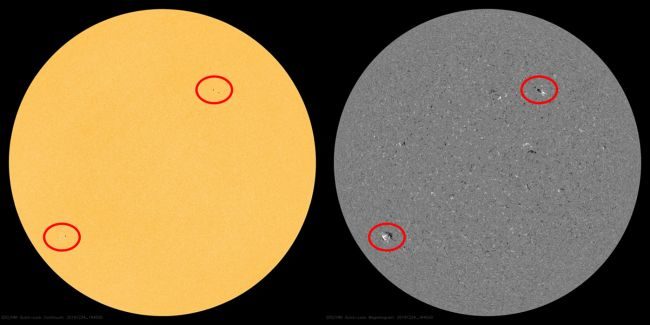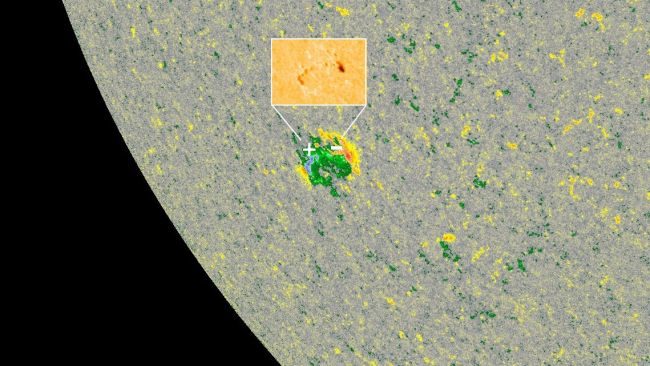
The two new sunspots, designated as NOAA 2753 and 2754, were seen on Dec. 24 by NASA's Solar Dynamics Observatory — a satellite that monitors the exterior and interior of the sun from a geosynchronous orbit more than 22,000 miles (more than 35,000 kilometers) above the Earth's surface.
These are the first significant sunspots seen since November 2019 and indicate the onset of a new sunspot cycle — known as Solar Cycle 25, or SC25 — that is expected to reach a new peak of magnetic activity in about five years.
Visible sunspots are caused by magnetic disturbances in the sun that displace its bright outer layer and reveal the slightly cooler (and darker) interior layers, usually for a few days but sometimes for several weeks. They can vary in size, but are usually vast — often much larger than the entire Earth.
"The sun was spotless from Nov. 14 until Dec. 23," said Jan Janssens, a communications specialist with the Solar-Terrestrial Centre of Excellence in Brussels, Belgium, which coordinates studies of the sun. "This 40-days stretch of spotless days is the longest in more than 20 years," he told Live Science in an email.
Such prolonged periods without sunspots usually happen around the time of what's called the "solar minimum" — the time of lowest sunspot activity between two solar cycles, Janssens said.
Though scientists won't have enough data for another six months to declare the start of a new sunspot cycle, "This seems to indicate that SC25 is gradually shaping up and that we are [at] or have passed the solar cycle minimum," Janssens said.

The 11-year sunspot cycles are caused by the sun's rotation in space, according to NASA. As the star rotates roughly once every 27 days, its material acts like a fluid, so that its equator rotates much faster than its poles do.
That makes the sun's powerful magnetic fields become progressively more "tangled" — and its sunspots and other magnetic activity more violent — until the entire star reverses its magnetic polarity (sort of like electric charge, but in this case, the state is either north or south). That's a bit as if the Earth switched its north and its south magnetic poles every few years.
The sun's change in polarity causes its magnetic activity — and its sunspots — to eventually die down, resulting in a solar minimum. But the sun's rotating magnetic field slowly gets tangled again, and the sunspot cycle begins anew.
Sunspots from the new and old cycles can overlap by months or even years, Janssens said, but the new ones can be distinguished as members of the new SC25 cycle by their magnetic polarity — the reverse of the old SC24 cycle.
The new spots also occurred at a relatively high latitude in the northern and southern hemispheres of the sun — between 25 and 30 degrees from the equator — while sunspots of the old cycle popped up within a few degrees of the equator, he said.
The SC25 cycle is now expected to reach a peak in about 2024, before declining to a new minimum in about 2031, according to a prediction by the Space Weather Prediction Center.
But "certainly in 2020 there are still many spotless days ahead and solar activity will remain very-low to low," Janssens said.
Solar minimum
When the new sunspot cycle reaches its peak, the increased magnetic activity of the sun could have significant effects here on Earth.
Large and complex sunspots can result in eruptions of radiation from the solar surface, known as solar flares; in powerful emissions of solar material known as proton storms; and in vast, dense clouds of energetic particles known as coronal mass ejections.
All three types of events can result in disruption to our communications, aircraft navigation and power grids, said solar physicist Dean Pesnell of NASA's Goddard Space Flight Center, the project scientist for the Solar Dynamics Observatory.
The charged particle from proton storms and coronal mass ejections can also create vivid auroras above the Earth.
Satellites in low-Earth orbits can suffer increased drag when the outer layers of the atmosphere are heated by solar activity, which can result in their orbits decaying more quickly; an increase in solar radiation can affect astronauts outside the Earth's protective magnetic field.
"All these things are what we see as space weather effects," Pesnell told Live Science: "harming our satellites, radiation doses to astronauts, satellite drag — all the effects that we worry about from the sun."



Comment: See also: